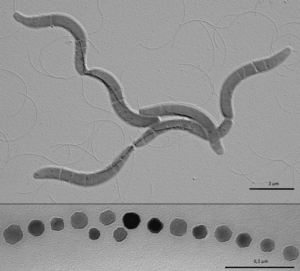Introduction to Magnetotactic Bacteria

Figure 1 - Model of magneto-aeotaxis. Magnetotactic bacteria (black) use the earth's magnetic field (gray lines) as guides to localize to the OATZ while other organisms (white) must rely on other methods for finding the same region. Courtesy of Komeili (
http://femsre.oxfordjournals.org/content/36/1/232.figures-only)

Figure 2- Electron micrograph of
Magnetospirillum gryphiswaldense cells containing chains of magnetite crystals (top) and magnified section of crystal chain (bottom). By Caulobacter subvibrioides (Diskussion) GFDL (
http://www.gnu.org/copyleft/fdl.html)], via Wikimedia Commons

Figure 3- Proposed model of magnetosome formation. "First, the reshaping of the inner cell membrane by MamI, MamL, MamQ, MamB, and other factors (green) creates the magnetosome membrane. Second, MamE is recruited to the nascent magnetosome. Third, MamE (in blue), independent of its protease activity recruits other proteins (red) to the magnetosome. Fourth, MamK and MamJ help to organize magnetosomes into chains. Note that this step is independent of biomineralization and may occur before or after crystal formation. Fifth, biomineralization is initiated, and small crystals of magnetite are formed. Finally, these small crystals are matured into large crystals in a step that requires the proteolytic activity of MamE." Komeili (2012) Courtesy of Komeili (
http://femsre.oxfordjournals.org/content/36/1/232.figures-only)
Magnetotactic bacteria (MB) are gram-negative bacteria that build specialized organelles called magnetosomes in order to store magnetic material and align themselves with the earth’s magnetic field. Magnetotactic bacteria were first described in 1975 when Richard Blakemore realized that a specific group of bacteria he collected from sediment constantly swam in the same geographic direction, regardless of the positioning of the microscope or external stimuli [1]. MB are mostly found in shallow aquatic environments where oxygen and other redox compounds are horizontally stratified and many described magnetotactic bacteria localize at or close to the oxic anoxic transition zone (OATZ)—a region in the water column that has very low oxygen levels [2]. The current model (shown in Figure 1) to explain the selective advantage provided by magnetosomes is that magnetotactic bacteria are able to locate the OATZ much easier than bacteria that solely use chemotactic and aerotactic mechanisms [3]. Although the magneto-aerotaxis model has been widely accepted amongst the scientific community, new research is suggesting that the behavior magnetotactic bacteria exhibit in the environment may be more complicated than a simple response to oxygen levels:
- Some MB species also show phototactic response, which helps reinforce magneto-aerotactic behavior and repel them from surface waters [4, 5]
- Genome sequences show that MB have some of the highest numbers of signaling proteins of Bacteria [6]
- MB produce more magnetosomes than necessary to align with the earth’s magnetic field [7]
- MB have been found near the equator, where their magneto-aerotactic behavior has no advantage [8]
Regardless of the actual biological function of magnetosomes, magnetotactic bacteria are a very interesting research topic because they have the potential to impact a large number of scientific and applied disciplines. Magnetosomes are the perfect model for the study of cellular organization and compartmentalization in bacteria because the formation of specialized features is usually attributed to eukaryotic organisms. Magnetotactic bacteria are also a great model for the study of [ biomineralization] because of the precise control over the composition, size and morphology of magenetite crystals in magnetosomes.
Magnetosome Formation
Include some current research in each topic, with at least one figure showing data.
Genetic Influences: the Magnetosome Island
Include some current research in each topic, with at least one figure showing data.
Applications in Bioremediation
Include some current research in each topic, with at least one figure showing data.
Other examples:
Bold
Italic
Subscript: H2O
Superscript: Fe [2]
References
[1] Blakemore, R. (1975). Magnetotactic bacteria. Science (New York, N.Y.), 190(4212), 377-379.
[2] Simmons, S. L., Sievert, S. M., Frankel, R. B., Bazylinski, D. A., & Edwards, K. J. (2004). Spatiotemporal distribution of marine magnetotactic bacteria in a seasonally stratified coastal salt pond. Applied and Environmental Microbiology, 70(10), 6230-6239.
[3] Komeili, A. (2012). Molecular mechanisms of compartmentalization and biomineralization in magnetotactic bacteria. FEMS Microbiology Reviews, 36(1), 232-255.
[4] Chen, C., Ma, Q., Jiang, W., & Song, T. (2011). Phototaxis in the magnetotactic bacterium magnetospirillum magneticum strain AMB-1 is independent of magnetic fields. Applied Microbiology and Biotechnology, 90(1), 269-275.
[5] Shapiro, O. H., Hatzenpichler, R., Buckley, D. H., Zinder, S. H., & Orphan, V. J. (2011). Multicellular photo‐magnetotactic bacteria. Environmental Microbiology Reports, 3(2), 233-238.
[6] Alexandre, G., Greer-Phillips, S., & Zhulin, I. B. (2004). Ecological role of energy taxis in microorganisms. FEMS Microbiology Reviews, 28(1), 113-126.
[7] Spring, S., Amann, R., Ludwig, W., Schleifer, K. H., van Gemerden, H., & Petersen, N. (1993). Dominating role of an unusual magnetotactic bacterium in the microaerobic zone of a freshwater sediment. Applied and Environmental Microbiology, 59(8), 2397-2403.
[8] Frankel, R. B., Blakemore, R. P., DE Araujo, F. F., Esquivel, D. M., & Danon, J. (1981). Magnetotactic bacteria at the geomagnetic equator. Science (New York, N.Y.), 212(4500), 1269-1270.
Other References:
[] Bazylinski, D. A., & Schübbe, S. (2007). Controlled biomineralization by and applications of magnetotactic bacteria. Advances in applied microbiology, 62, 21-62.



